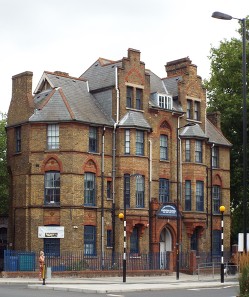





Exploring Southwark and discovering its history


Latest Pages:
Lady Gomm House
Lady Gomm House is a late Victorian building that has survived both the bombs in the second world war and the redevelopment of the immediate vicinity. It has a long history of varied community focussed activities from the original mission house and hospital to the present special needs school of today. The building is named after Lady Elizabeth Gomm, second wife to Lord of the Manor of Rotherhithe, Sir William Maynard Gomm.

Sir William had a long (over sixty years) and illustrious career in the army. His career reads like a history lesson, amongst the many events in his action-packed career were fighting at the Battle of Waterloo and being Commander in Chief of the Army in India. He inherited the Manor of Rotherhithe in 1822 from his aunt Jane Gomm who had been a governess to George III’s daughters. She had worked alongside another royal governess, Martha Goldsworthy, who had inherited the Manor of Rotherhithe from her brother in 1801. Such good friends were Jane and Martha that when they retired, they lived together in Hill Street, Mayfair and Martha bequeathed the manor of Rotherhithe to her “good and worthy friend and companion, Jane Gomm.”
In the 1890s, the Sisters of the Church ran seven Missions within poor parts of London where they lived and worked among the poor and sick within a strongly evangelical religious framework. The work carried out in their missions included Sunday Schools, breakfast ragged schools, classes for older scholars, bible-classes for men and women and mother’s meetings. Their mission in Rotherhithe was combined with an Accident Hospital where men who had suffered injury as a result of accidents in the docks were admitted and treated free of charge. Known also as The Cottage Hospital, there was also a dispensary where those less seriously injured, or suffering from other illnesses, could be treated. The Sisters of the Church also visited the sick in their own homes.
Lady Gomm House was bombed towards the beginning of the Second World War and whilst the building was still standing and structurally sound, the Sisters of the Church moved out to Wimbledon. They did not return after the end of the war, perhaps in anticipation of the formation of the National Health Service, and the hospital closed. In 1946, the hospital trustees, M C Carr-Gomm and Colonel Bairstow offered a 99 year lease to Bede House, a local settlement, at a peppercorn rent.
Bede House had grown out of the Princess Marie Louise Settlement in Jamaica Road which had closed in 1937. The new settlement was unable to use the old building and moved into a disused bakery on Southwark Park Road which had cost £400 and paid for with money that had been raised by the previous users of the Princess Marie Louise Settlement. Bede House opened in 1939 and was able to provide help during the war: there was an air raid shelter in the basement, a Boy Scout messenger centre, they helped co-ordinate evacuation, they ran an advice centre to help those who had lost their homes due to bombing and they organised a meal centre.
The premises on Southwark Park Road were completely bombed out during the war and after receiving the offer of Lady Gomm House, Bede House set about raising funds for the renovation and the new settlement opened in December 1948. It was home to an LCC Maternity and Welfare Clinic, a Mother’s Club, a Veteran’s Club, a Docker’s Club, a Leisure Club for the Disabled, Adult Education Classes and clubs for different age groups of children, from a play group to a youth club for older teenagers.
The Abbeyfield Road estate adjoining Lady Gomm House was built in the 1960s as part of the area’s redevelopment after the war and a new, purpose built facility for Bede House was included. By the early 1970s, Lady Gomm House had been acquired by Southwark Council and the building was used over the years as a social services office, an office for a mental health team and a day centre for those with mental health problems. The current occupiers, Cavendish School, moved in in 2005 and very soon afterwards purchased the building.
Sources:
Memorials to serve for the History of the Parish of St Mary, Rotherhithe
History of Lady Gomm House on the Cavendish School website
Katharine Bradley (2004) Bringing People Together: Bede House in Bermondsey and Rotherhithe 1938-2003

Sir William died aged 90 in 1875 and Lady Elizabeth died two years later. By the terms of her will, she bequeathed £5000, the income from which was to be used for the benefit of old men and old women residing in the districts of Rotherhithe. The charity was to be called “The Sir William and Lady Gomm Charity.” Lady Elizabeth (right) also bequeathed additional money to be used for the good of the people of Rotherhithe, and this money was used to build the Lady Elizabeth Memorial Mission Hall and Accident Hospital in Hawkstone Road. It was opened in 1885, managed and administered by the Sisters of the Church.